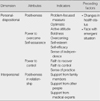Abstract
Purpose
The purpose of this study was to define and clarify the concept of 'resilience' in patients with cardiovascular diseases.
Methods
A hybrid model was used to develop the concept of resilience. The model included a field study carried out in Cheonan, Korea. The participants in this study were 9 patients with cardiovascular diseases who underwent a percutaneous coronary intervention.
Results
The concept of resilience was found to be a complex phenomenon having meanings in two dimensions: the personal-dispositional and interpersonal dimensions. Four attributes and seven indicators were defined.
Conclusion
A resilient person was defined as one who has a positive attitude toward restoration, the power to reconstruct and control his/her disease (personal dimension), and support from a supportive system with supportive persons (interpersonal dimension). In the clinical setting, resilience plays an important role in managing the care plans of cardiovascular patients. Therefore, nurses who work closely with patients suffering from cardiovascular diseases should be aware of the attributes and indicators of resilience to enhance the resilience of their patients.
Figures and Tables
Table 1
Dimensions, Attributes, Indicators and Preceding Factors of Resilience from Cardiovascular Disease in Literature Review

References
1. Bellin MH, Kovacs PJ. Fostering resilience in siblings of youths with a chronic health condition: A review of the literature. Health & Social Work. 2006. 31:209–216.
2. Chan IW, Lai JC, Wong KW. Resilience is associated with better recovery in Chinese people diagnosed with coronary heart disease. Psychology & Health. 2006. 21:335–349.
3. Choi EH. The lived experience of the acute myocardial infarction patients. 2002. Seoul: Chungang University;Unpublished master's thesis.
4. Curtin M, Lubkin I. Lubkin I, editor. What is chronicity? Chronic illness: Impact and interventions. 1995. 3rd ed. Sudbury, MA: Jones & Bartlett;3–25.
5. David R, Holmes J. State of the art in coronary intervention. American Journal of Cardiology. 2003. 91:50–53.
6. Gallo LC, Ghead SG, Bracken WS. Emotions and cognitions in coronary heart disease: Risk, resilience, and social context. Cognitive Therapy and Research. 2004. 28:669–694.
7. Gillespie BM, Chaboyer W, Wallis M, Grimbeek P. Resilience in the operating room: Developing and testing of a resilience model. Journal of Advanced Nursing. 2007. 59:427–438.
8. Health Insurance Statistics. National Health Insurance Corporation. 2009. 06. 25. Retrieved December 21, 2009. from
http://www.nhic.or.kr/cms/board/board/Board.jsp?act=VIEW&communityKey=B0039&boardId=4344.
9. Hodges HF, Keeley AC, Troyan PJ. Professional resilience in baccalaureate-prepared acute care nurses: First steps. Nursing Education Perspectives. 2008. 29(2):80–89.
10. Jang HS. Social-emotional development: Resilience as a factor interrupting psychological disorders. The Korean Journal of Development Psychology. 2001. 14:113–127.
11. Ju SY, Lee YH. Child maltreatment and resilience: Mediating effects of cognitive function and social support. The Journal of Child Studies. 2008. 29:127–156.
12. Jung YH, Ko SJ. Estimating socioeconomic costs of five major diseases. Journal of Public Finance. 2004. 18:77–104.
13. Kim DH, Yoo IY. Relationship between depression and resilience among children with nephrotic syndrome. Journal of Korean Academy of Nursing. 2004. 34:534–540.
14. Kim HS. Concept development of resilience. Journal of Korean Academy of Nursing. 1998. 28:403–413.
15. Korean National Statistic Office. 2006 Leading causes of death. 2007. Daejeon: Author.
16. Lee IS. Effectiveness and development of family psychoeducation program for improving of family resilience-targeted the family with mental illness children-. Journal of Family Relations. 2004. 9:221–239.
17. Lee IS, Park YS, Song MS, Lee EO, Kim HS, Park YH, et al. A study on the development of the Korean family resilience scale. Journal of Korean Academy of Nursing. 2005. 32:560–569.
18. Lee KS, Min YC. Psychological adjusting process to diseases in people with chronic illnesses. Journal of Korean Academy of Psychiatric and Mental Health Nursing. 2008. 17:151–160.
19. Lee WJ. Resilience and protective factors in at-risk children. The Journal of Child Studies. 2002. 23:1–16.
20. Luthar SS, Zigler E. Vulnerability and competence: A review of research on resilience in childhood. The American Journal of Orthopsychiatry. 1991. 61:6–22.
21. Merriam-Webster. Merriam-Webster Dictionary of the English Language. 2002. 4th ed. Boston, MA: Houghton Mifflin.
22. Merz C, Dwyer J, Nordstrom C, Walton K, Salerno J, Schneider R. Psychosocial stress and cardiovascular disease: Pathophysiological links. Behavioral Medicine. 2002. 27:141–147.
23. Oh HK, Lee KB. A study on school resilience of the students with disabilities. Social Welfare Policy. 2006. 24:285–315.
24. Oh SA, Lee YH. Factor scale development related to resilience in families of children with disabilities. The Journal of Korea Early Childhood Education. 1999. 6(2):21–48.
25. Schwartz-Barcott D, Kim HS. Rodgers BL, Knafl KA, editors. An expansion and elaboration of the hybrid model of concept development. Concept Development in Nursing: Foundations, Techniques, and Applications. 2000. Philadelphia, PA: W. B. Saunders Co.;129–159.
26. Shin SJ. Health locus of control and compliance of treatment in acute coronary syndrome patients after percutaneous coronary intervention. The Journal of Korean Academy of Adult Nursing. 2008. 20:829–838.
27. Sohn HS. Effects of ego-resilience and learned helplessness on academic achievement. Research Review. 2006. 14:1–22.
28. Standard Korean Language Dictionary. The National Institute of the Korean Language. 2008. 10. 08. Retrieved January 5, 2009. from
http://www.korean.go.kr/08_new/index.jsp.
29. Strauss AL, Corbin JM. Basics of qualitative research: Grounded theory, procedures and techniques. 1990. Newbury Park, CA: Sage Publications.
30. Suh JY. A study of the influence of parental divorce on children's adaptation: Focusing on resilience. 2002. Seoul: Yonsei University;Unpublished doctoral dissertation.
31. Tusaie K, Dyer J. Resilience: A historical review of the construct. Holistic Nursing Practice. 2004. 18:3–10.
32. Walsh F. Strengthening family resilience. 1998. New York, NY: Guilford Press.
33. Yang OK, Choi MM. Korean's han and resilience application to mental health social work. Mental Health & Social Work. 2001. 11:7–29.
34. Yoo AJ, Lee JS, Kim JM. The impacts of bodyimage, attachment to parent and peers, and resilience on adolescents' life satisfaction. Journal of Korean Home Management Association. 2005. 23(5):123–132.




 PDF
PDF ePub
ePub Citation
Citation Print
Print





 XML Download
XML Download